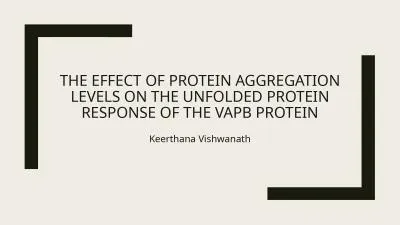

on the Unfolded Protein Response OF The VAPB protein Keerthana Vishwanath Amyotrophic Lateral Sclerosis ALS What is ALS What are the two types of ALS ALS is typically caused by mutation ID: 914143
Download Presentation The PPT/PDF document "The effect of Protein Aggregation Levels" is the property of its rightful owner. Permission is granted to download and print the materials on this web site for personal, non-commercial use only, and to display it on your personal computer provided you do not modify the materials and that you retain all copyright notices contained in the materials. By downloading content from our website, you accept the terms of this agreement.
Slide1
The effect of Protein Aggregation Levels on the Unfolded Protein Response OF The VAPB protein
Keerthana Vishwanath
Slide2Amyotrophic Lateral Sclerosis (ALS)What is ALS?What are the two types of ALS?
ALS is typically caused by mutation
Slide3Vesicle Associated Membrane Protein Associated Protein B (VAPB)Integral Protein in Endoplasmic Reticulum (ER)Functions
Unfolded Protein Response (UPR)
Detection of misfolded/unfolded proteins
Degrades via ubiquitination proteasome system (UPS)
Correction via increased production of molecular chaperones
Known Mutations of VAPB:
P56S—Proline at codon 56 to Serine
T46I—Threonine at codon 46 to Isoleucine
Slide4VAPB Function
http://www.cell.com/cms/attachment/2021787539/2041707744/fx1.jpg
MSP domain of VAPB (N-terminal)
Cleavage and secretion
Acts as ligand for receptors
Receptors control muscle mitochondria structure and function
Slide5Familial ALS8
MSP domain of VAPB (N-terminal)
NO
Cleavage
and
secretion—due to P56S mutation
NO ligand to control LAR and ROBO-like receptors
Causes Actin remodeling in the muscle mitochondria
Muscle mitochondria structure and function are altered
http://www.cell.com/cms/attachment/2021787539/2041707744/fx1.jpg
Slide6Why Use YeastHomologyScs2 gene
Transformation Process
Slide7Central QuestionDoes the level of protein aggregation caused by different mutations in the transformed yeast cells with the mutated VAPB
affect
the UPS of the UPR in the protein?
Can the UPS be inhibited to interfere with the function of the UPR of the protein? If so, what is the level at which the protein aggregation accomplishes this?
Slide8Goals of the ExperimentCreate a library of mutants
Using
error-prone Polymerase Chain Reaction (EP-PCR)
Slide9Goals of the ExperimentMeasure the protein aggregation caused by each mutation
Fluorescent dye
ProteoStat
Figure shows the detection of amyloid plaques in normal and Alzheimer’s brain tissue using
ProteoStat
Slide10Results and Possible Issue(s)Result—Protein aggregation levels of transformed yeast cells with the mutated VAPB gene strains will be higher than those of the original transformed yeast cells with wild-type VAPB
Why is this important?
Possible Issue(s):
These are conclusions drawn within transformed yeast cells—would need to test this in human VAPB to be sure that the aggregation levels would cause for the display of ALS8 symptoms
Slide11References
1. Chen, S.,
Sayana
, P., Zhang, X., & Le, W. (2013). Genetics of amyotrophic lateral sclerosis: an update. Retrieved from
https://www.ncbi.nlm.nih.gov/pmc/articles/PMC3766231/
2. Amyotrophic lateral sclerosis - Genetics Home Reference. (2016). Retrieved from
https://ghr.nlm.nih.gov/condition/amyotrophic-lateral-sclerosis#statistics
3. VAPB gene - Genetics Home Reference. (2016). Retrieved November, from
https://ghr.nlm.nih.gov/gene/VAPB
4. Nishimura
, Agnes L., et al. “A common founder for amyotrophic lateral sclerosis type 8 (ALS8) in the Brazilian population.” SpringerLink, Springer-
Verlag, 27 Sept. 2005, https://link.springer.com/article/10.1007%2Fs00439-005-0031-y.5. Suzuki, H, et al. “ALS-Linked P56S-VAPB, an aggregated loss-of-Function mutant of VAPB, predisposes motor neurons to ER stress-Related death by inducing aggregation of co-Expressed wild-Type VAPB.”
Journal of neurochemistry., U.S. National Library of Medicine, Feb. 2009, www.ncbi.nlm.nih.gov/pubmed/19183264/.
6. Larroquette, F, et al. “Vapb/Amyotrophic lateral sclerosis 8 knock-in mice display slowly progressive motor behavior defects accompanying ER stress and
autophagic response.” Human molecular genetics., U.S. National Library of Medicine, 15 Nov. 2015, www.ncbi.nlm.nih.gov/pubmed/26362257/.
7. “SCS2.” SCS2 | SGD, 2000, www.yeastgenome.org/locus/SCS2.
8.
Blokhuis
, Anna M., et al.
“Protein aggregation in amyotrophic lateral sclerosis.”
Acta
Neuropathologica
, Springer-
Verlag
, June 2013,
www.ncbi.nlm.nih.gov/pmc/articles/PMC3661910/
.
9.
Gregoire
, Simpson, et al. “Techniques for Monitoring Protein
Misfolding
and Aggregation in Vitro and in Living Cells.”
The Korean journal of chemical engineering
, U.S. National Library of Medicine, June 2012,
www.ncbi.nlm.nih.gov/pmc/articles/PMC3615250/
.
10.
Qiu
,
Linghua
, et al. “Widespread aggregation of mutant VAPB associated with ALS does not cause motor neuron degeneration or modulate mutant SOD1 aggregation and toxicity in mice.”
Molecular Neurodegeneration
,
BioMed
Central, 2013,
www.ncbi.nlm.nih.gov/pmc/articles/PMC3538568/
.
11. Ding, Wen-Xing, et al. “Linking of Autophagy to Ubiquitin-Proteasome System Is Important for the Regulation of Endoplasmic Reticulum Stress and Cell Viability.”
The American Journal of Pathology
, American Society for Investigative Pathology, Aug. 2007,
www.ncbi.nlm.nih.gov/pmc/articles/PMC1934546/
.
12.
Genevini
, Paola, et al. “Amyotrophic Lateral Sclerosis-Linked Mutant VAPB Inclusions Do Not Interfere with Protein Degradation Pathways or Intracellular Transport in a Cultured Cell Model.”
PLoS
ONE
, Public Library of Science, 2014,
www.ncbi.nlm.nih.gov/pmc/articles/PMC4237408/
.
13. “PROTEOSTAT® Protein aggregation assay.”
PROTEOSTAT® Protein aggregation assay - ENZ-51023 - Enzo Life Sciences
, 14 Nov. 2016,
www.enzolifesciences.com/ENZ-51023/proteostat-protein-aggregation-assay/
.
14. Yang, Bin, et al. “Widespread aggregation of mutant VAPB associated with ALS does not cause motor neuron degeneration or modulate mutant SOD1 aggregation and toxicity in mice.”
Molecular Neurodegeneration
,
BioMed
Central, 3 Jan. 2013,
https://molecularneurodegeneration.biomedcentral.com/articles/10.1186/1750-1326-8-1
.
15.
Sabel
, Jaime, and Nicola Brookman-
Amissah
. “Integrated DNA Technologies.”
Methods for site-Directed mutagenesis
, IDT,
www.idtdna.com/pages/decoded/decoded-articles/core-concepts/decoded/2012/01/10/methods-for-site-directed-mutagenesis
.
Slide12References
16.
Deidda
, I.,
Galizzi
, G.,
Passantino
, R.,
Cascio, C., Russo, D., Colletti, T., . . . Guarneri, P. (2014, March). Expression of vesicle-associated membrane-protein-associated protein B cleavage products in peripheral blood leukocytes and cerebrospinal fluid of patients with sporadic amyotrophic lateral sclerosis. Retrieved December 12, 2017, from
https://www.ncbi.nlm.nih.gov/pubmed/2437295317. VAPB
. (n.d.). Retrieved December 12, 2017, from https://www.sciencedirect.com/topics/biochemistry-genetics-and-molecular-biology/vapb
18. Sanhueza, M., Zechini, L., Gillespie, T., & Pennetta, G. (2014, January 15). Gain-of-function mutations in the ALS8 causative gene VAPB have detrimental effects on neurons and muscles. Retrieved December 12, 2017, from
http://bio.biologists.org/content/3/1/59
19. Introduction to Yeast Transformation. (n.d.). Retrieved December 06, 2017, from https://www.sigmaaldrich.com/technical-documents/protocols/biology/introduction-to-yeast-transformation.html
20. Shen, D., Coleman, J., Chan, E., Nicholson, T. P., Dai, L., Sheppard, P. W., & Patton, W. F. (2011, July). Novel Cell- and Tissue-Based Assays for Detecting Misfolded and Aggregated Protein Accumulation Within
Aggresomes and Inclusion Bodies. Retrieved December 06, 2017, from https://www.ncbi.nlm.nih.gov/pmc/articles/PMC3112480/
21. Error-Prone
PCR Diagram. (
n.d.
). Retrieved December 06, 2017, from
http://2007.igem.org/wiki/index.php/Error_prone_PCR